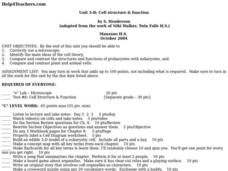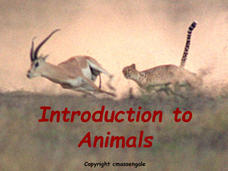Curated OER
Organelles
Young scholars explore the functions of major eukaryotic organelles. They compare and contrast prokaryotic and eukaryotic cells. Given diagrams and drawings, students take turns drawing structures, discussing their function, and...
Curated OER
Cell Me What?
Students compare and contrast the characteristics of robots and cells. For this biology lesson, students examine the parts and function of cell organelles. They create a visual representation of their cell/robot analogy.
Curated OER
Cell Structure and Function
High schoolers identify the main ideas of different cell theories. Using a microscope, they compare and contrast the structures and functions of prokaryotes and eukaryotes. They also compare and contrast animal and plant cells and...
Curated OER
Cell Structure and Function
In this cells worksheet, students review the different types of cells. Students identify the organelles found in an animal cell and determine the function of these organelles. This worksheet has 14 matching, 6 fill in the blank, and 5...
Curated OER
Cell Reviews
Pupils draw cells, make a cell, and list organelles in plant and animal cells. In this cells lesson plan, students create edible cells.
Curated OER
Protists
Sort through the "junk drawer kingdom" as the protists laugh at our attempts to classify them! AP biology classes consider the array of organisms that do not file neatly into the other four kingdoms of classification. Evidence for the...
Curated OER
Cellular Respiration Oxidation of Pyruvate Krebs Cycle
Diagrams with annotations are shown on each of these eighteen slides, which summarize the processes of respiration. The focus is on the 3-step oxidation process and the Krebs cycle. Students should be able to follow these slides...
Curated OER
Classification/Taxonomy/Statistics Review
"Does King Phillip Cry Over Flimsy Grass Stems?" You might not answer that question with this exhaustive worksheet, but your biology class will get the full scoop on the hierarchy of biological classification with this resource. It...
Curated OER
Biology: Understanding Cellular Organelles
Students distinguish the differences between Prokaryotic and Eukaryotic cells. Using microscopes, they examine a variety of plant and animal cells. Working in groups, they draw and label plant and animal cells and show the mathematical...
Curated OER
Diversity of Life
Students identify the difference between eukaryote and prokaryotes and examine the structure of bacteria. In this bacteria lesson students examine the different ways that bacteria are classified through an activity.
Curated OER
A View of the Cell
In this viewing of a cell activity, students will read a paragraph about how microscopes work and will use a diagram of a light microscope to complete 2 short answer questions.
Curated OER
Studying Living Organisms
Students discover and discuss the differences between prokaryotes and eukaryotes. Using a microscope, they examine various prepared slides of prokaryotic and eukaryotic organisms.
Curated OER
DNA Technologies
After giving some of the basic characteristics of the DNA molecule, the slides provide process information and many detailed diagrams about plasmids, vectors, and their application in cloning genes.
Biology Junction
Introduction to Animals
Out of all animals, elephants alone lack the ability to jump. Scholars learn all about animals using a presentation full of fun examples. It describes different types of animals, the biological similarities and differences between...
Curated OER
DNA: Structure and Replication Movie
In this DNA: structure and replication worksheet, students fill in the blanks about the structure of DNA and replication of DNA. Students sketch several diagrams of DNA at different stages.
Curated OER
The Sponges
In this sponge worksheet, students read about the different parts of a sponge and answer 20 short answer questions that follow. They color and label different sponge drawing.
Curated OER
Atomic Structure and Bonding
Eighth graders discuss and write about what led up to the discovery of the atom. Students label proton, nucleus, electron, and neutron in their notes. Students take notes on electron shells and how different atoms have different...
Curated OER
Gaia: The Wisdom of the Earth
Learners are introduced to Gaia theory of natural homeostasis. They graph Earth's temperatures over time, construct terrariums or monitor the outdoor environment. Related videos titles are suggested, but may be outdated. The objectives...
Curated OER
Classification of Life
In this classification of life worksheet, students use an on line source to answer questions about how species are classified, named and grouped. They give the classification of a bear, an orchid and a sea cucumber.
Curated OER
Taxonomy
In this biology worksheet, students complete a crossword puzzle with 39 questions on taxonomy. They identify the different classification systems used in biology.
Other
Midlands Technical College: The Eukaryotic Cell
The structure of a eukaryotic cell is explained using clear, detailed diagrams and accompanying text. A chart comparing the major differences between prokaryotic and eukaryotic cells is also presented.
CK-12 Foundation
Ck 12: Plix: Prokaryotic and Eukaryotic Cells
[Free Registration/Login Required] Using a Venn diagram, drag the blue tiles into each part to correctly sort the characteristics of Prokaryotic and Eukaryotic cells.
Cells Alive
Cells Alive!: Plant, Animal, and Bacteria Cell Models
Find animated diagrams that describe both eukaryotic cells and prokaryotic cells. There are models for animal, plant, and bacteria cells.
Florida State University
Florida State University: Molecular Expressions Cell Biology: Animal Cell Structure
Site highlights the various features of an animal cell. Presents users with a colorful diagram depicting the anatomy of the animal cell. Provides links to obtain more detailed information about the various components found in animal cells.

























